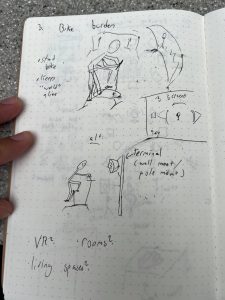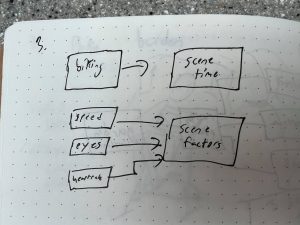1 – Restless Garden
I want to create a garden of animatronic plants that can “come alive” or “die” based on the restlessness (or stress or other factors) of the user using it. The idea is to create a space that reflects the mental state of the person using it -> if stressed or anxious, the garden comes alive and animates, but if you’re calm it can go dormant or wilt and die. The setting for this would be someone’s bedroom, a studio, study, or other space that we spend a lot of time in alone.
The motivation for this is twofold:
– I really want to think about spaces people live in and how they can reflect yourself, your mental state, etc.
– I want to think more about the effects of various types of “restlessness.”
I think that restlessness can be really negative or positive depending on a lot of factors. I think restlessness describes the psychological feeling of wanting change or really driving for something (possibly without a clear goal.) Complete restlessness can be crippling, but total lack of restlessness is stagnation. I like the idea but I’m not _really_ sure yet how this actually says anything or works haha.
The garden itself would be made out of real plants with pulleys, lights, and other actuators to move them around. They could also be fake plants or some sort of more abstracted “plant.” Speakers would create atmospheric noise. There’s a lot of “biome” options here, like windy plains, spooky lake (loon calls!), active jungle, etc. There could be “creatures” as well.
The “restlessness” sensor could come from a lot of places. Heartbeat is really easy to measure, but you could also do things like blood oxygen, eye tracking, motion tracking, some sort of interactive quiz interface, etc. You could use a fitbit or apple watch or something I guess that have biometrics, but I don’t own any of those.
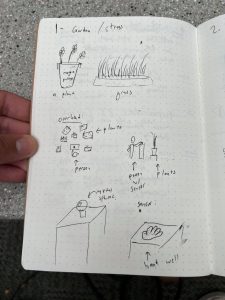
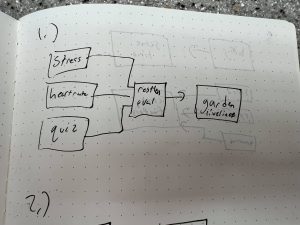
2 – Speakers
The speakers project would use the circular speaker arrangement in the Ideate Media Room. The idea is to have each speaker play an independent acoustic scene: a forest, a party, a speech, a playground, a backpacking trip, a concert, a car ride, a corporate presentation, an argument, etc. The scenes would reflect life events, weekend excursions, political events, career moments, and other things like that.
Each user can only use the setup exactly once. A fingerprint scanner (or similar) allows you to start the experience, and if you’ve used it before it will reject you.
When the user is in the center of the room, the sounds are all muffled and not very distinguishable. There’s little clarity and you can’t really experience any of the sounds directly. Approaching a speaker “focuses” the sound and lets you listen closely to the scene, but all of the other scenes totally fade away. A faint heartbeat plays in the background under everything else. While you’re focused on one scene, the other scenes evolve and change in the background.
The basic premise is to force the user to commit to certain scenes, knowing that they will not experience the whole thing. The fingerprint authentication prevents any replaying or going back. If you’re indecisive and remain in the middle, the scenes stay muffled and you won’t experience anything. If you commit hard to one scene, you’ll totally miss what’s going on in the others. There’s no way to experience all of the scenes. (unless you’re me 🙂 )
The physical setup is simple: Just a big circle of speakers and some way of detecting where the user is in the room. The easiest would be to use the Media Room’s motion capture system to get a highly accurate 3d position, but you could also use rangefinder sensors or something and just detect that a user is at a single speaker or not. I really like the idea of the sounds fading very smoothly, though, so I would probably try to just use the mocap system if it feels like the range is good enough.
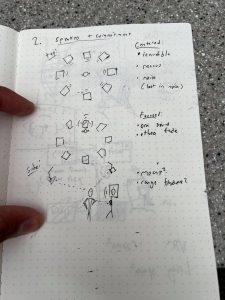
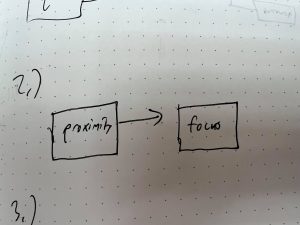
3 – Bike to stay alive?
My housemate likes to jam on his guitar for hours a day. He uses a loop pedal, and slowly builds up textures and little songs for an hour at a time. The loop pedal is really basic and there’s really no way of saving your work. If you get bored or accidentally clear it, your whole piece is totally gone.
Bike to stay alive or “Commitment Bike.” The idea here is to have a scene of sorts that evolves as the user bikes on an exercise bike. If the user stops biking, the scene dies and can’t be replicated. Kind of inspired by Tamagotchis and loop pedals.
The core principle is that the whole scene you come up with is totally ephemeral, and you know you can’t bike forever to keep it going. At some point, there’s an element of choice on whether to continue biking in the current scene, or if you should stop and allow it to reset. You might just get tired and pause momentarily and lose the whole scene. I think the success here is really tied to what kind of scenes I can come up with.
Ideas for the scene:
– Something fully acoustic: synthesized chords and music.
– A procedural world that slowly grows with complexity. (unity or something, could project on screens, use vr, etc.)
– A chatbot that you can interact with. I don’t think this would work because chatbots don’t usually have state that really grows over the course of an interaction. (Maybe a real phone call instead?)
Things to incorporate into the scenes:
– Some sort of dataset visualization stuff, similar to the mattress factory installations with waves and satellites.
– Incorporate 3d scans of living spaces. I think that’s a cool way to get a window into people’s lives.
– Measured data from the user on the bike, like speed, consistency, etc. They could bike with some sort of intention that can change how the scene comes out.
